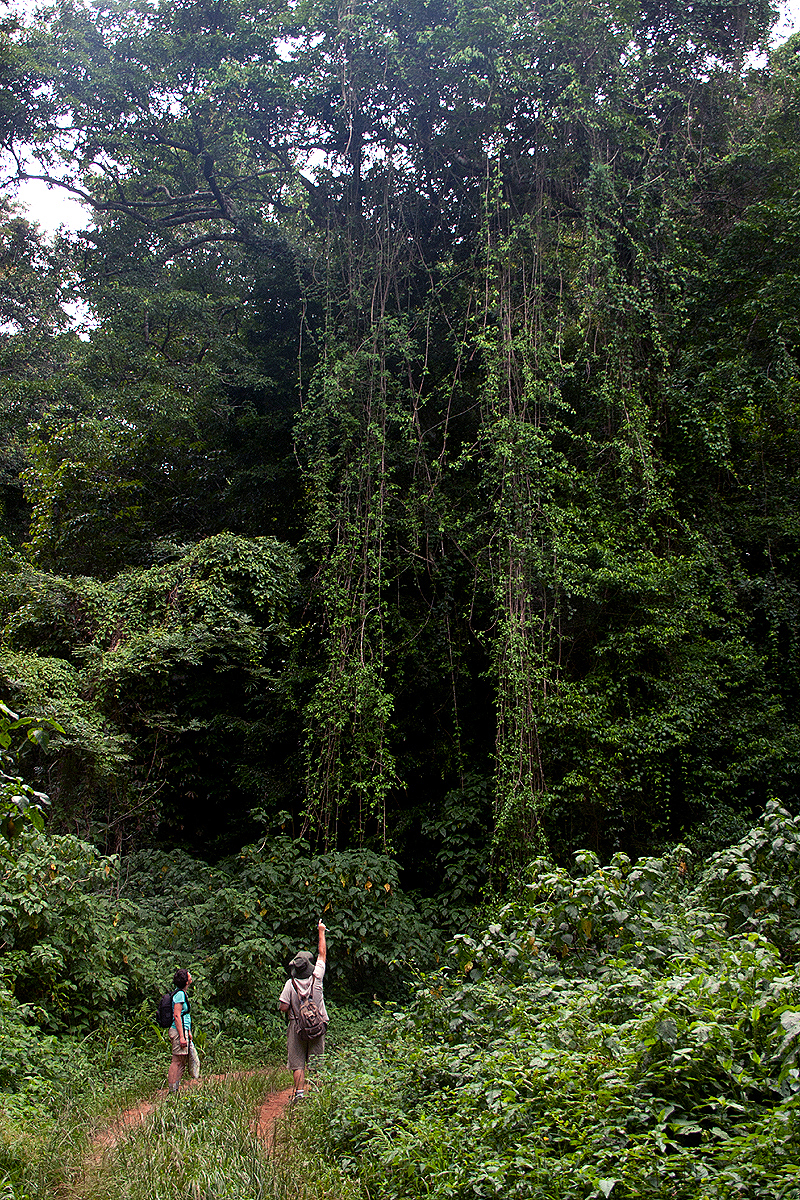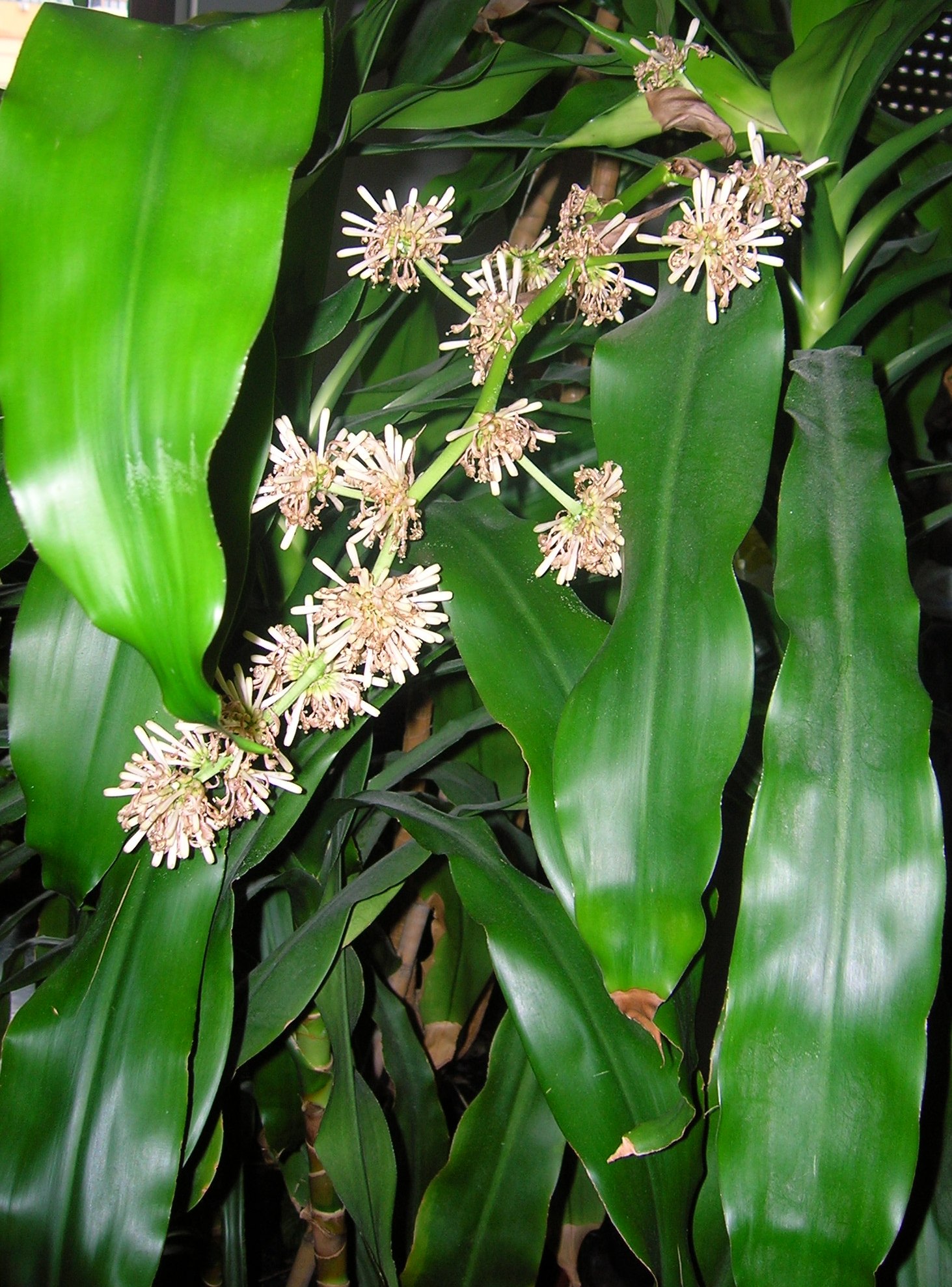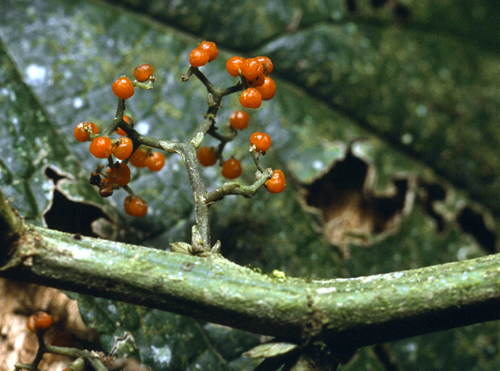|
Chirinda Forest Botanical Reserve
The Chirinda Forest Botanical Reserve is situated on the slopes of Mount Selinda, south of Chipinge, in the Chipinge Highlands of Manicaland, Zimbabwe, and is administered by the Forestry Commission. The reserve is situated at between in altitude, and receives some to of annual rainfall. of its higher levels, above , is covered by moist evergreen forest, specifically Zanzibar-Inhambane transitional rain forest, of which it represents the southernmost occurrence. The headwaters of three streams, namely the Zona, Chinyika and Musangazi, drain the two broad highlands which it encloses. The boundaries of the reserve are not strictly enforced, so that cattle grazing and plant harvesting are ongoing. The reserve is surrounded by communal settlements, commercial timber plantations (eucalypts and pines) and small-scale commercial farming units. The naturalist Charles Swynnerton was appointed manager of the nearby Gungunyana farm in 1900, and a number of plant, bird and insect names ... [...More Info...] [...Related Items...] OR: [Wikipedia] [Google] [Baidu] |
Dracaena Fragrans
''Dracaena fragrans'' (cornstalk dracaena), is a flowering plant species that is native throughout tropical Africa, from Sudan south to Mozambique, west to Côte d'Ivoire and southwest to Angola, growing in upland regions at altitude.JSTOR Plant Science''Dracaena fragrans''/ref> It is also known as striped dracaena, compact dracaena, and corn plant. Description ''Dracaena fragrans'' is a slow growing shrub, usually multistemmed at the base, mature specimens reaching or more tall with a narrow crown of usually slender erect branches. Stems may reach up to diameter on old plants; in forest habitats they may become horizontal with erect side branches. Young plants have a single unbranched stem with a rosette of leaves until the growing tip flowers or is damaged, after which it branches, producing two or more new stems; thereafter, branching increases with subsequent flowering episodes.Huxley, A., ed. (1992). ''New RHS Dictionary of Gardening'' 2: 96. Macmillan . The leaves are ... [...More Info...] [...Related Items...] OR: [Wikipedia] [Google] [Baidu] |
Uapaca Kirkiana
''Uapaca kirkiana'', the sugar plum or mahobohobo, is a species of dioecious plant in the family Phyllanthaceae. It is native to the southern Afrotropics, where it occurs in well-watered miombo woodlands. Within range it is one of the most popular wild fruits. It is rarely cultivated but trees are left when land is being cleared. Still a traditional food plant in Africa, this little-known fruit has the potential to improve nutrition, boost food security, foster rural development and support sustainable land care. In Shona, the fruit are referred to as ''mazhanje'', and in Chichewa ''masuku''. Range It occurs in the miombo woodlands of Angola, the DRCongo, Zambia, southern Burundi, Tanzania, Malawi, central and northern Mozambique, and Zimbabwe Zimbabwe (), officially the Republic of Zimbabwe, is a landlocked country located in Southeast Africa, between the Zambezi and Limpopo Rivers, bordered by South Africa to the south, Botswana to the south-west, Zambia to th ... [...More Info...] [...Related Items...] OR: [Wikipedia] [Google] [Baidu] |
Big Tree In Chirinda Forest
Big Tree (or The Big Tree in Chirinda Forest) is the tallest indigenous tree in Zimbabwe, and a declared National Monument. The tree is 65 metres tall and 4.5 metres wide. Its age is approximately 1,000 years. The tree is located in the centre of Chirinda Forest (formerly known as Selinda) in southeast Zimbabwe at the southernmost part of the country's Eastern Highlands. Big Tree is a ''Khaya anthotheca'' or Nyasa redwood tree (previously referred to as ''Khaya nyasica''). In December 1986, it reached 65 metres tall and 5.25 metres wide. The trunk is heavily buttressed at the base, which complicates measurement. Conservation Big Tree is protected within the Chirinda Forest Botanical Reserve, administered by Zimbabwe Parks and Wildlife Estate. It sustained damage from people carving their initials into it. The tree is dying, indicated by its declining height and the loss of its topmost branches. Whether this is due to human damage or a natural process is unknown. Other tall ''Khaya ... [...More Info...] [...Related Items...] OR: [Wikipedia] [Google] [Baidu] |
Drypetes Gerrardii
''Drypetes gerrardii'' is a species of small tree or large shrub in the family Putranjivaceae. Common names include forest ironplum, bastard white ironwood, and forest ironwood. It is native to tropical and subtropical central and eastern Africa. It was first described in 1920 by the English botanist John Hutchinson, who named it after the English botanist William Tyrer Gerrard who collected plants and seeds in southern Africa in the 1860s. Description ''Drypetes gerrardii'' is a small tree or large evergreen shrub, growing to a height of about . The trunk is fluted and buttressed in larger trees, and the bark is smooth. Small branches and twigs are squarish in cross section and are clad in golden hairs when young. The leaves are alternate and held in one plane. The blades are ovate to elliptic and up to long, shiny dark green above and pale green below with a felting of pale hairs on the leaf stalk and the midrib. The leaf margin is entire or lightly toothed and the tip acute ... [...More Info...] [...Related Items...] OR: [Wikipedia] [Google] [Baidu] |
Trichilia Dregeana
''Trichilia dregeana'', commonly known as the forest natal-mahogany, is a tree in the family Meliaceae. These trees are found in forest areas from the Eastern Cape of South Africa to Tropical Africa Although tropical Africa is mostly familiar to the West for its rainforests, this biogeographic realm of Africa is far more diverse. While the tropics are thought of as regions with hot moist climates, which are caused by latitude and the trop .... Description The 7 to 11 leaflets of the large compound leaf have 7 to 12 lateral veins, typically less than the related Natal mahogany. The dehiscent fruit is reddish brown, spherical and about 3 cm in diameter. As with the Natal mahogany, each black seed is almost enveloped by a red aril. Gallery File:Trichilia dregeana, vrugte, Waterkloofrif, b.jpg, File:Trichilia_dregeana_fruit.JPG, Fruit and black seeds with red arils File:Trichilia_dregeana.JPG, Seeds and compound leaf File:Trichilia dregeana, lower, Waterkloofrif, a.jp ... [...More Info...] [...Related Items...] OR: [Wikipedia] [Google] [Baidu] |
Strychnos Mellodora
''Strychnos mellodora'' is a species of plant in the Loganiaceae family. It is found in Kenya, Mozambique, Tanzania, and Zimbabwe Zimbabwe (), officially the Republic of Zimbabwe, is a landlocked country located in Southeast Africa, between the Zambezi and Limpopo Rivers, bordered by South Africa to the south, Botswana to the south-west, Zambia to the north, and Mozam .... References mellodora Vulnerable plants Taxonomy articles created by Polbot {{Gentianales-stub ... [...More Info...] [...Related Items...] OR: [Wikipedia] [Google] [Baidu] |
Strychnos Mitis
''Strychnos'' is a genus of flowering plants, belonging to the family Loganiaceae (sometimes Strychnaceae). The genus includes about 100 accepted species of trees and lianas, and more than 200 that are as yet unresolved. The genus is widely distributed around the world's tropics and is noted for the presence of poisonous indole alkaloids in the roots, stems and leaves of various species. Among these alkaloids are the well-known and virulent poisons strychnine and curare. Etymology The name ''strychnos'' was applied by Pliny the Elder in his '' Natural History'' to ''Solanum nigrum''. The word is derived from the Ancient Greek στρύχνον (''strúkhnon'') – "acrid", "bitter". The meaning of the word ''strychnos'' was not fixed in Ancient Greece, where it could designate a variety of different plants having in common the property of toxicity. Distribution The genus has a pantropical distribution. Taxonomy The genus is divided into 12 sections, though it is conceded that ... [...More Info...] [...Related Items...] OR: [Wikipedia] [Google] [Baidu] |
Celtis Mildbraedii
''Celtis mildbraedii'' is a species of forest tree in the family Cannabaceae. It was previously assigned to the family Ulmaceae. These trees grow in limited areas of South Africa, Mozambique and Zimbabwe. They are also found in forested areas from West Africa to Sudan, DRC, Angola and Tanzania. Common names include natal white stinkwood, red-fruited white-stinkwood and natal elm. This species is more common in Tropical Africa than in Southern Africa. There are about forty specimens in Pigeon Valley Natural Heritage Park, Durban, South Africa. The southernmost specimen is found in Ilanda Wilds Nature Reserve in Amanzimtoti. The fruit of the tree turns red as it ripens but viable seed is difficult to find. No Natal White Stinkwoods were available from plant nurseries in South Africa in 2009 suggesting that this tree species is not being propagated, despite its rarity in South Africa. This tree is a dominant species in the moist semi-deciduous forests of Ghana along with ''Triploch ... [...More Info...] [...Related Items...] OR: [Wikipedia] [Google] [Baidu] |
Argomuellera Macrophylla
''Argomuellera'' is a genus of plant of the family Euphorbiaceae first described as a genus in 1894. It is native to sub-Saharan Africa, Madagascar, and the Comoros The Comoros,, ' officially the Union of the Comoros,; ar, الاتحاد القمري ' is an independent country made up of three islands in southeastern Africa, located at the northern end of the Mozambique Channel in the Indian Ocean. It ... Islands.Govaerts, R., Frodin, D.G. & Radcliffe-Smith, A. (2000). World Checklist and Bibliography of Euphorbiaceae (and Pandaceae) 1-4: 1-1622. The Board of Trustees of the Royal Botanic Gardens, Kew. ;Species ;Formerly included moved to '' Droceloncia'' or Pycnocoma * ''Argomuellera reticulata'' - '' Pycnocoma reticulata'' * ''Argomuellera rigidifolia'' - '' Droceloncia rigidifolia'' Notes References Pycnocomeae Euphorbiaceae genera {{Euphorbiaceae-stub ... [...More Info...] [...Related Items...] OR: [Wikipedia] [Google] [Baidu] |
Ficus Chirindensis
''Ficus'' ( or ) is a genus of about 850 species of woody trees, shrubs, vines, epiphytes and hemiepiphytes in the family Moraceae. Collectively known as fig trees or figs, they are native throughout the tropics with a few species extending into the semi-warm temperate zone. The common fig (''F. carica'') is a temperate species native to southwest Asia and the Mediterranean region (from Afghanistan to Portugal), which has been widely cultivated from ancient times for its fruit, also referred to as figs. The fruit of most other species are also edible though they are usually of only local economic importance or eaten as bushfood. However, they are extremely important food resources for wildlife. Figs are also of considerable cultural importance throughout the tropics, both as objects of worship and for their many practical uses. Description ''Ficus'' is a pantropical genus of trees, shrubs, and vines occupying a wide variety of ecological niches; most are evergreen, b ... [...More Info...] [...Related Items...] OR: [Wikipedia] [Google] [Baidu] |
Gambeya Gorungosana
''Gambeya gorungosana'' is species of evergreen tree native to eastern and central Africa. Range and habitat ''Gambeya gorungosana'' ranges across eastern and central Africa, from Mozambique and Zimbabwe through Zambia, Malawi, Tanzania, Burundi, Rwanda, and eastern Democratic Republic of the Congo The Democratic Republic of the Congo (french: République démocratique du Congo (RDC), colloquially "La RDC" ), informally Congo-Kinshasa, DR Congo, the DRC, the DROC, or the Congo, and formerly and also colloquially Zaire, is a country in ... to Uganda and Kenya, and in Angola, Gabon, and Cameroon. It is a characteristic tree in the Afromontane rain forests of the tropical African highlands, generally found on higher-rainfall slopes between 1200 and 2500 meters elevation.White, Frank F. (1983). ''The vegetation of Africa: A descriptive memoir to accompany the Unesco/AETFAT/UNSO vegetation map of Africa''. UNESCO, 1983. ISBN 92-3-101955-4 References {{taxonbar, from = Q55 ... [...More Info...] [...Related Items...] OR: [Wikipedia] [Google] [Baidu] |
Urera Trinervis08
''Urera'' is a genus of flowering plants in the nettle family, Urticaceae. It has a pantropical distribution.Steinmann, V. W. (2005)Four new neotropical species and a new combination of ''Urera'' (Urticaceae).''Acta Botánica Mexicana'' (71), 19-43. Description ''Urera'' are lianas,''Urera''. Flora Zambesiaca. s, and small s. Climbing species root along the stems and can reach the crowns of the trees they use for support. Some are spiny. The ... [...More Info...] [...Related Items...] OR: [Wikipedia] [Google] [Baidu] |



